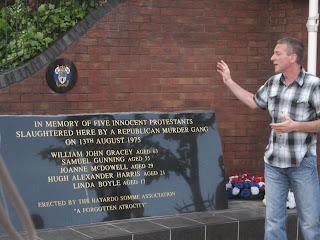 From there, the capital building can be seen, a landmark that is almost impossible to miss with its large ferris wheel located directly adjacent to it. Fifteen minutes later we arrived at Belfast Exposed because Nina recognized the construction site that we have to pass before getting to Belfast Exposed from afar and exclaimed “I see Patton, I know where we are!!” All in all, we only got confused, but never lost, for a few minutes on our way.
From there, the capital building can be seen, a landmark that is almost impossible to miss with its large ferris wheel located directly adjacent to it. Fifteen minutes later we arrived at Belfast Exposed because Nina recognized the construction site that we have to pass before getting to Belfast Exposed from afar and exclaimed “I see Patton, I know where we are!!” All in all, we only got confused, but never lost, for a few minutes on our way. When we walked in the doors a few minutes late we actually had an assignment waiting for us. Pauline, the director of the Gallery is leading and participating in two talks for which she needed some background information and research.
 Both of the talks relate to the current exhibition of Immigration around the world. The first talk pertains to the new border control regulations and deportation processes for the United Kingdom as well as other countries around the world. For this talk, Pauline needed to give some up to date information on individual deportation campaigns that have been raised. This was an interesting assignment, and one that I was not particularly expecting because it did not pertain only to Northern Ireland, the main theme of our studies. My research lead me to find many accounts of people traveling and immigrating to the United Kingdom as a whole, and two families in the Republic of Ireland.
Both of the talks relate to the current exhibition of Immigration around the world. The first talk pertains to the new border control regulations and deportation processes for the United Kingdom as well as other countries around the world. For this talk, Pauline needed to give some up to date information on individual deportation campaigns that have been raised. This was an interesting assignment, and one that I was not particularly expecting because it did not pertain only to Northern Ireland, the main theme of our studies. My research lead me to find many accounts of people traveling and immigrating to the United Kingdom as a whole, and two families in the Republic of Ireland.The topic of immigration is not one that I know much about, even though it is a very hot topic in the United States too in recent years. I enjoyed being able to take the time to learn some more about immigration and deportation issues. I found that there were numerous blog entries from various people about controversial deportation occurrences. Newspapers and other news sources publish stories of individual family situation and then individuals take up issue to bring further awareness to the public and create a support network for the struggling families.
One of the stories in which I noticed this occurrence was the deportation of the Nigerian family of Olivia Agbanlahor and her six year old twins Great and Melissa. They moved Clonakility, a town in the south of the Republic of Ireland in order to escape the dangerous living situations in Nigeria. In 2006, Justice Minister Michael McDowell signed an order to deport the family. Soon after, Great was diagnosed with Autism, a condition that is associated with possession by evil spirits in Nigeria. If forced to move back to Nigeria, Great would both be ostracized and unable to receive the constant support and medical care needed. Olivia stated that she no longer has family in Nigeria and her children have never been there. She also said that it would be a death sentence for Great to be sent back to Nigeria after being diagnosed with Autism.
These kinds of stories are heart wrenching and create a sense of community within people who read about, support or are involved in the process. I understand that governments cannot bend their rules for every single sad case that comes up because almost everyone that immigrates to a new country is leaving some kind of hardship. Each family has it’s own emotional story and it is extremely sad that some people just do not have the opportunity to remain in safety. I wonder how the families that I researched are making out after being deported back to their home countries and I hope they have managed to find safety and security.



